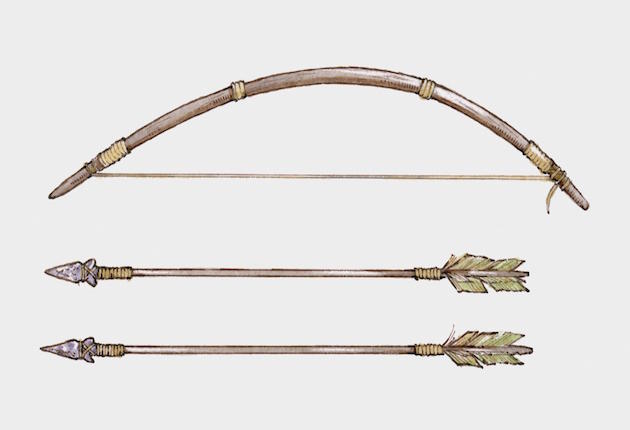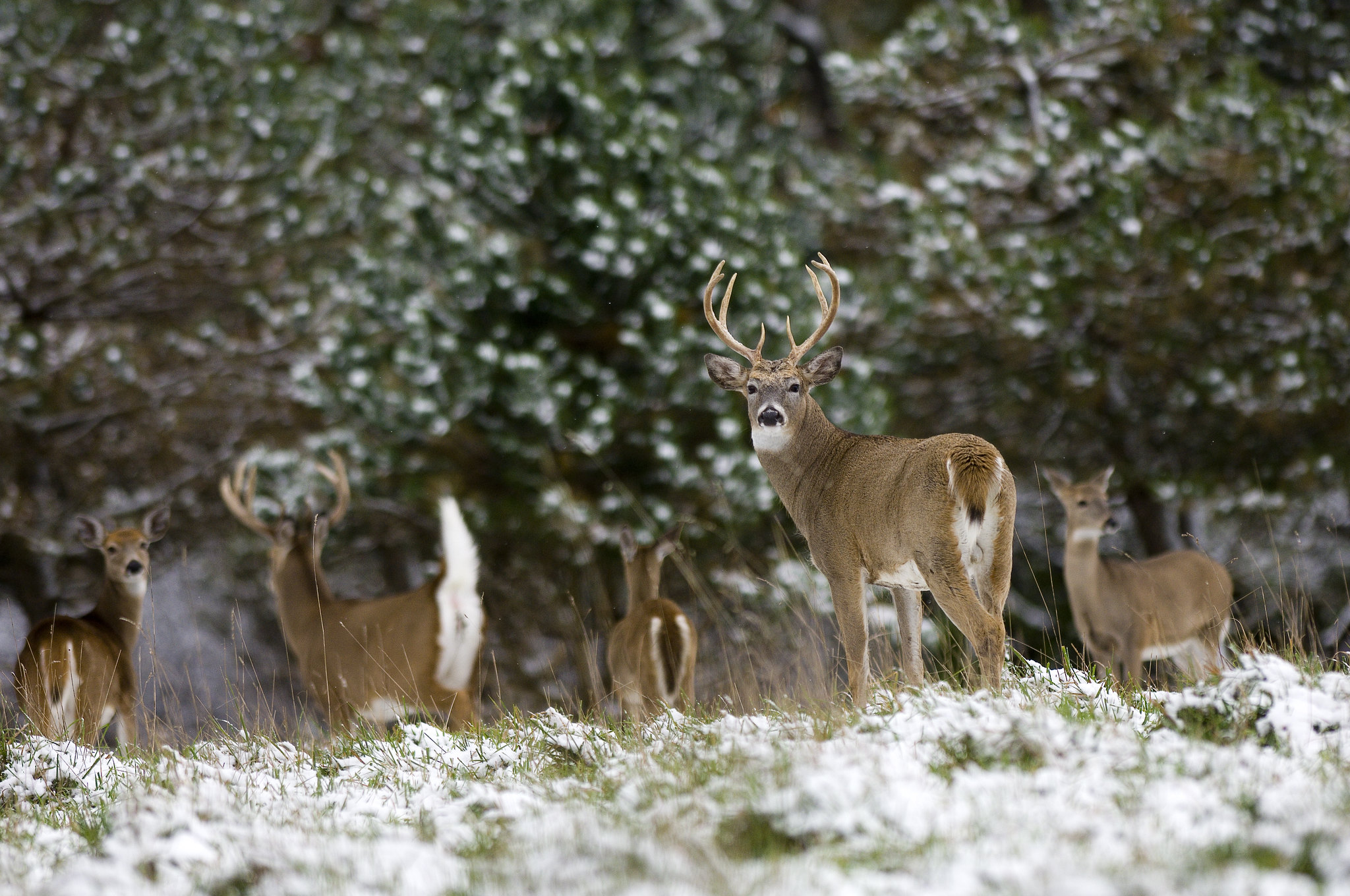Saxton Pope—doctor, writer, outdoorsman and avid bowhunter, explains the step-by-step process of shooting a bow and arrow.
Saxton Pope has been dead for nearly a century, but 21st-century archers can still get a personal bow and arrow shooting lesson from the master via his writings. Saxton Pope—doctor, writer, outdoorsman, and avid bowhunter—died in 1926. He helped bring bows and arrows out of the history books and into the modern era. While he used longbows of his own making, his lessons on shooting with stick and string are still informative for present-day archers. They also offer a glimpse into the not-too-distant past and the opinions of an archery legend.
Editor’s note: Below is an excerpt from Pope’s Hunting with the Bow and Arrow. Some changes were made to the punctuation and spelling of the original manuscript, but the overall spirit of the piece was unaffected.
Hunting with the Bow and Arrow
First, brace your bow. To do this properly, grasp it at the handle with your right hand, the upper horn upward and the back toward you. Place the lower horn at the instep of your right foot, and the base of your left palm against the back of the bow, near the top below the loop of the string.
Holding your left arm stiff and toward your left side, your right elbow fixed on your hip, pull up on the handle by twisting your body so that the bow is sprung away from you. The string is now relaxed, and the fingers of the left hand push it upward till it slips in the nock.
Don’t try to force the string, and don’t get your fingers caught beneath it. Do most of the work with the right hand pulling against the rigid left arm.
The proper distance between the bow and the string at the handle is six inches. This is ordinarily measured by setting the fist on the handle and the thumb sticking upright, where it should touch the string. This is the ancient “fistmele”—an archer’s measure also used in measuring lumber.
Hunting bows should be strung a little less than this because of the prolonged strain on them. Target bows shoot cleaner when higher strung.
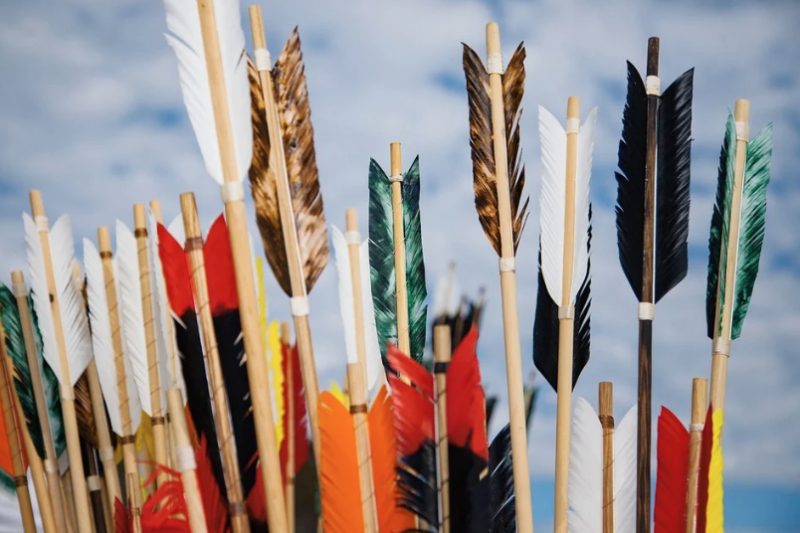
Change your bow to your left hand and drop the arm so that the upper end of the bow swings across the body in a horizontal position. Draw an arrow from the quiver with the right hand and carry it across the bow till it rests on the left side at the top of the handle.
Place the left forefinger over the shaft and keep it from slipping while you shift your right hand to the arrow-nock, thumb uppermost. Push the arrow forward, at the same time rotating it until the cock feather, or that perpendicular to the nock, is away from the bow.
As the feathers pass over the string and the thumb still rests on the nock, slip the fingers beneath the string and fit it in the arrow-nock.
Now turn the bow upright and remove your left forefinger from its position across the shaft. The arrow should rest on the knuckles without lateral support. Now place your fingers in position for shooting.
The release used by the old English is the best. This consists in placing three fingers on the string—one above the arrow, two below. The string rests midway between the last joint and the tip of the finger. The thumb should not touch the arrow, but lie curled up in the palm.
The release used by children consists in pinching the arrow between the thumb and forefinger, and is known as the primary loose. This type is not strong enough to draw an arrow halfway on a hunting bow.
Proper Stance for Bow and Arrow Shooting
Stand sidewise to your mark, with the feet eight or ten inches apart, at right angles to the line of shot. Straighten your body, stiffen the back, expand the chest, turn the head fully facing the mark, look at it squarely, and draw your bow across the body, extending the left arm as you draw the right hand toward the chin.
Draw the arrow steadily, in the exact plane of your mark, so that when the full draw is obtained and the arrowhead touches the left hand, the right forefinger touches a spot on the jaw perpendicularly below the right eye and the right elbow is in a continuous line with the arrow. This point on the jaw below the eye is fixed and never varies; no matter how close or how far the shot, the butt of the arrow is always drawn to the jaw, not to the eye, nor to the ear. Thus the eye glances along the entire length of the shaft and keeps it in perfect line.
The bow hand may be lowered or raised to obtain the proper elevation and length of flight. The left arm is held rigidly but not absolutely extended and locked at the elbow. A slight degree of flexion here makes for a good clearance of the string and adds resiliency to the shot.
The arrow is released by drawing the right hand further backward at the same time the fingers slip off the string. This must be done so firmly, yet deftly, that no loss of power results, and the releasing hand does not draw the arrow out of line. Two great faults occur at this point: one is to permit the arrow to creep forward just before the release, and the other is to draw the hand away from the face in the act of releasing.
Keep your fingers flexed and your hand by your jaw. All the fingers of the right hand must bear their proper share of work. The great tendency is to permit the forefinger to shirk and to put too much work on the ring finger.
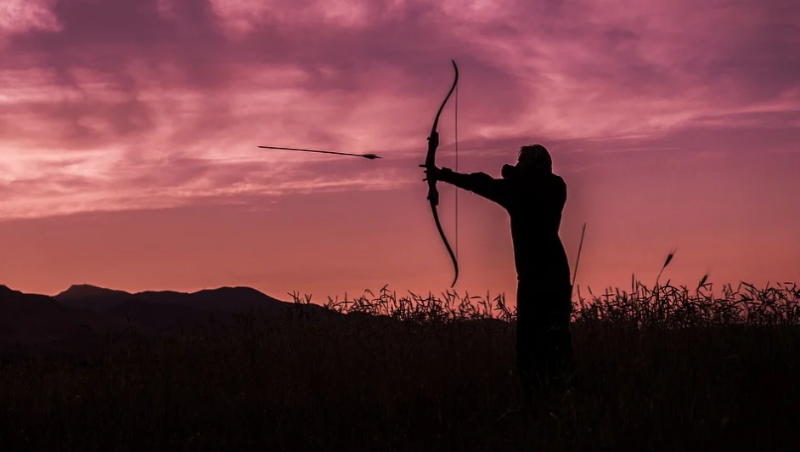
If the arrow has a tendency to fall away from the bow, tip the upper limb ten degrees to the right and pull more on the right forefinger; start the draw with the fingers more acutely flexed, so that as the arrow is pinched between the first and second fingers and as they tend to straighten out under the pressure of the string, the arrow is pressed against the bow, not away from it.
In grasping the bow with the left hand, it should rest comfortably in the palm and loosely at the beginning of the draw. The knuckle at the base of the thumb should be opposite the center of the bow, the hand set straight on the wrist. As you draw, be sure that the arrow comes up in a straight line with your mark, otherwise the bow will be twisted in the grasp and deflect the shot. Then fully drawn, set the grasp of the left hand without disturbing the position of the bow, make the left arm as rigid as an oak limb; fix the muscles of the chest; make yourself inflexible from head to toe. Keep your right elbow up and rivet your flight.
The method of aiming in game shooting consists in fixing binocular vision on the object to be hit, drawing the nock of the arrow beneath the right eye, and observing that the head of the arrow is in a direct line with the mark by the indirect vision of the right eye. Both eyes are open, both see the mark, but only the right observes the arrowhead; the left ignores it. Your vision must be so concentrated upon one point that all else fades from view. Just two things exist—your mark and your arrowhead.
At a range of 60 or 80 yards, the head of the arrow seems to touch the mark while aiming. This is called point-blank range. At shorter lengths the archer must estimate the distance below the mark on which his arrow seems to rest in order to rise in a parabolic curve and strike the spot. At greater ranges he must estimate a distance above the mark on which he holds his arrow in order to drop it on the object of his shot.
“Do not imagine that we are infallible in our shooting. Some of the most humiliating moments of our lives have come through poor shooting. Just when we wanted to do our best, before an expectant gathering, we have done our most stupid missing.”
If his shaft flies to the left, it is because he has not drawn the nock beneath his right eye, or he has thrown his head out of line, or the string has hit his shirt sleeve, or something has deflected the arrow.
If it falls to the right, it is because he has made a forward, creeping release, or weakened in his bow arm, or in drawing to the center of the jaw instead of the angle beneath the eye.
If the arrow rattles on the bow as it is released, or slaps it hard in passing, it is because it is not drawn up in true line, or because it fits too tightly on the string, or because the release is creeping and weak. Always draw fully up to the barb.
If his arrows drop low and all else is right, it is because he has not kept his tension, or has lowered his bow arm.
After the arrow is released, the archer should hold his posture a second, bow arm rigidly extended, drawing hand to his jaw, right elbow horizontal. This ensures that he maintains the proper position during the shot. There should be no jerking, swinging, or casting motions; all must be done evenly and deliberately.
The shaft should fly from the bowstring like a bird, without quiver or flutter. All depends upon a sharp, resilient release.
Having observed all the prerequisites of good shooting, nothing so ensures a keen, true arrow flight as an effort of supreme tension during the release. The chest is held rigid in a position of moderate inspiration, the back muscles are set, and every tendon is drawn into elastic strain; in fact, to be successful, the whole act should be characterized by the utmost vigor.
To get the best instructions for shooting the bow, one should read Sir Roger Ascham in Toxophilus and Horace Ford in Archery.
Game Shooting vs. Target Shooting
Game shooting differs from target shooting in that, with the latter, a point of aim is used, and the archer fixes his eyes upon this point, which is perpendicular above or below the bull’s-eye. The arrowhead is held on the point of aim, and when loosed, flies not along the line of vision, but describes a curve upward, descends, and strikes not the point of aim, but the bull’s-eye.
The field archer should learn to estimate distances correctly by eye. He should practice pacing measured lengths so that he can tell how many yards any object may be from him.
In hunting, he should make a mental note of this before he shoots. In fact, we nearly always call the number of yards before we loose the arrow.
Where a strong crosswind exists, a certain amount of windage is allowed. But up to 60 yards the lateral deflexion from wind is negligible; past this it may amount to three or four feet.
In clout shooting and target practice, one must take wind into consideration. In hunting we only consider it when approaching game, as a carrier of scent, because our hunting ranges are well under a hundred yards and our heavy hunting shafts tack into the wind with little lateral drift.
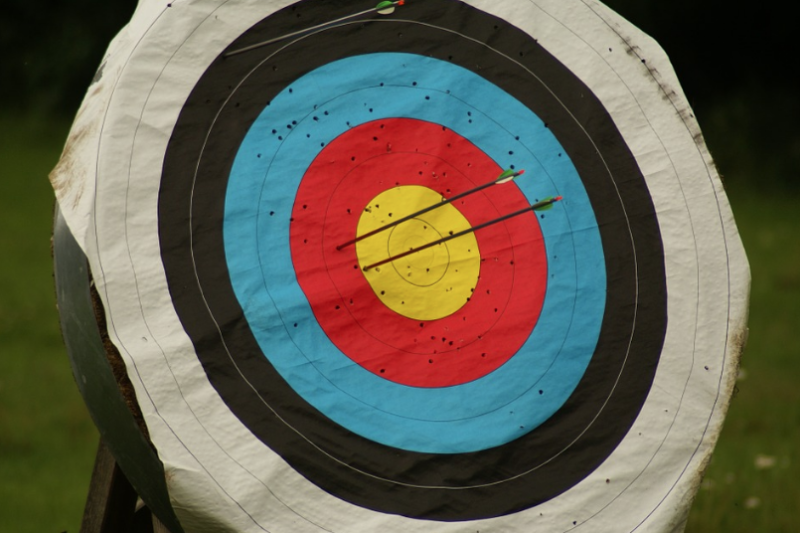
No matter how much a man may shoot, he is forever struggling with his technique. I remember getting a letter from an old archer who had shot the bow for more than 50 years. He was past 70 and had to resort to a 35-pound weapon. He complained that his release was faulty, but he felt that with a little more practice he could perfect his loose and make a perfect shot. Since writing he has entered the Happy Hunting Grounds—still a trifle off in form.
Even a sylvan archer needs to practice form at the targets. He should study the game from its scientific principles as formulated by Horace Ford, the greatest target shot ever known.
The point-of-aim system and target practice improve one’s hunting. Hunting, on the other hand, spoils one’s target work. The use of heavy bows so accustoms the muscles to gross reactions that they fail to adjust themselves to the finer requirements of light bows and to the precise technique of the target range.
The field archer gets his practice by going out in the open and shooting at marks of any sort, at all distances, from five to 200 yards. A bush, a stray piece of paper, a flower, a shadow on the grass—all are objects for his shafts.
The open heath, shaded forest, hills and dales, all make good grounds. As he comes over a knoll, a bush on the farther side represents a deer; he shoots instantly. He must learn to run, to stop short and shoot; fresh or weary, he must be able to draw his bow and discharge one arrow after another. With the bow unstrung walking along the trail, often we have stopped at the word of command, strung the bow, drawn an arrow from the quiver, nocked it, and discharged it within the space of five seconds. Deliberation, however, is much more desirable.
Bow and Arrow Shooting Positions
Let several archers go into the fields together and roam over the land, aiming at various marks; it makes for robust and accurate game shooting.
Shooting an exact line is much easier than getting the exact length. For this reason it is easier to split the willow wand at 60 or 80 yards than it seems.
Often we have tried this feat to amuse ourselves or our friends, and seldom more than six arrows are needed to strike such a lath or stick at this distance. Hitting objects tossed in the air is not so difficult either. A small tin can or box thrown 15 or 20 feet upward at a distance of ten or 15 yards can be hit nearly every time, especially if the archer waits until it just reaches the apex of its course and shoots when it is practically stationary.
Shooting at swinging objects helps to train one in leading running or flying game.
Turtle shooting—that form in which the arrow is discharged directly upward and is supposed to drop on the mark—is difficult and attended with few hits, but it trains one in estimating wind drift.
An archer should also learn the elevation or trajectory at which his arrows fly at various distances. Shooting in the woods overhanging limbs may interfere with a good shot. In this case the archer can kneel and thus lower his flight to avoid interception.
In kneeling, it seems that the right knee should be on the ground, while the left foot is forward. This is a natural pose to assume during walking, and the left thigh should be held out of the way of the bow string. When not in use, but braced, the bow should be carried in the left hand, the string upward, the tip pointing forward. It never should be swung about like a club, nor shouldered like a gun.
Shooting from horseback is not impossible, but it must be done off the left side of the horse, and a certain amount of practice is necessary for the horse as well as for the archer.
It is surprising how accurately one can shoot at night. Even the dimmest outline will serve the bowman, and his shaft has an uncanny way of finding the mark.
Missing the Mark
When it comes to missing the mark, that is the subject for a sad story. It takes an inveterate optimist to stand the moral strain of persistent missing. In fact, it is this that spoils the archery career of many a tyro—he gives up in despair. It looks so easy, but really is so difficult to hit the mark.
But do not be cast down, keep eternally at practice, and ultimately you will be rewarded. Nothing stands a man in such good stead in this matter as to have started shooting in his youth.
And do not imagine that we are infallible in our shooting. Some of the most humiliating moments of our lives have come through poor shooting. Just when we wanted to do our best, before an expectant gathering, we have done our most stupid missing. But even this has its compensations and inures us to defeat.
It is a striking fact that we shoot better when confronted by the game itself. Under actual hunting conditions you will hit closer to your point than on the target field.
Study every move for clean, accurate shooting, and analyze your failures so that you can correct your faults. Extreme care and utmost effort will be rewarded by greater accuracy.
Other things being equal, it is the man who shoots with his heart in his bow that hits the mark.
Images: Pixabay
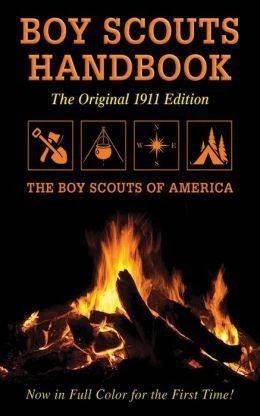 This is a full-color edition of the very first Boy Scouts Handbook, complete with the wonderful vintage advertisements that accompanied the original 1911 edition, Over 40 million copies in print!
This is a full-color edition of the very first Boy Scouts Handbook, complete with the wonderful vintage advertisements that accompanied the original 1911 edition, Over 40 million copies in print!
The original Boy Scouts Handbook standardized American scouting and emphasized the virtues and qualifications for scouting, delineating what the American Boy Scouts declared was needed to be a “well-developed, well-informed boy.” The book includes information on: The organization of scouting, Signs and signaling, Camping, Scouting games, Description of scouting honors and more. Scouts past and present will be fascinated to see how scouting has changed, as well as what has stayed the same over the years. Buy Now

